Many-sided "Lightning" by Arado
Arado Ar-234 entered the world history aviation as the first jet bomber to take part in hostilities. This aircraft was used by the Luftwaffe in the autumn of 1944 as a scout, and at the end of the year began to deliver bombing attacks on Anglo-American troops.
And its history began in the autumn of 1940, when the German Ministry of Aviation (RLM) issued to Arado Flyugtsogverke a technical task for the development of a single-seater long-range reconnaissance jet aircraft. To ensure the distance to 2000 km, designers V. Blum and H. Rebeski, taking into account the fact that the task did not envisage group take-off of the aircraft, decided to abandon the conventional chassis. Instead, under the fuselage mounted retractable ski, and to ensure stability, on the run under the engine nacelles, provided a small support skis. The plane was planned to take off using a three-wheeled drop launch car with front swivel and main brake wheels. Starting trolley was equipped with a brake parachute.
The car of the company "Arado" was a high-profile aircraft with two Junkers suspended under a two-jet wing of the Jumo 004 TRD. In the forward part of the fuselage was located the cockpit of the pilot, in the tail section - the photographic equipment compartment. At the end of 1941, the design of the aircraft, which received the name Ar 234A „Blitz“ (Lightning) in RLM, was ready. Planned to build eight experimental machines. By the end of 1941, the first Jumo 004A engines with 800 kgf were expected to be received, but problems with their development delayed delivery until the spring of the 1943 year.
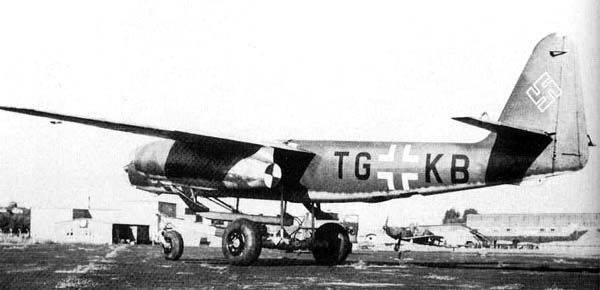
The first experienced Ar 234V1 took off 15 June 1943 of the year (this car later crashed during tests). The second copy of Ar 234V2 took off almost a month later, but also crashed during tests. The third Ar 234V3, considered as a prototype of the A series, differed from the previous ones in a hermetic cabin, installing an ejection seat and suspension nodes on nacelles, additional HWK 501 rocket accelerators. The first flight of them was made in August 1943 of the year, but during the tests and he received serious damage. The fourth car did not differ much from the previous ones, and on the fifth one, we installed Jumo 100B-004 motors, lightened with 0 kg, with a weight of 850 kgf.
While the Ar 234A was being developed, the situation at the fronts did not change in favor of Nazi Germany, therefore, even before the test flights of the experimental RLM aircraft made adjustments to the terms of reference, reorienting the project to develop a high-speed bomber. For this reason, all work on Ar 234A stopped.
Three prototypes were retained for testing individual components and assemblies of the designed aircraft of the following series. For example, the sixth and eighth prototype had four BMW 003A turbojet engines, each with an 800 kgf engine designed for the C-series vehicles. On the sixth prototype aircraft, the first flight of which took place in early April, 1944 of the year, were placed in separate gondolas, and on the eighth plane - in twin (this option became a model for the series C). On the seventh vehicle, the Jumo 004B TRD was installed with a 900 kg barge intended for series B. This car crashed in the middle of summer 1944 due to a fire in the left engine, and the test pilot Zelle died.
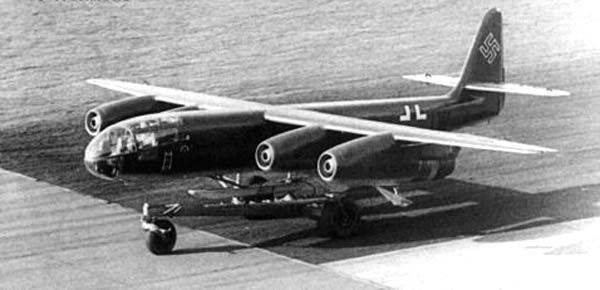
The design of the Ar 234B single bomber began at the very end of 1942 of the year. The appearance of the predecessor was fully preserved; however, to take off the aircraft from any aerodrome without special devices, including the group, the ski landing gear with the starting carriage was replaced with a built-in tricycle. Because of this, we had to slightly increase the width of the fuselage and reduce the volume of the fuel tank.
Rack chassis equipped with low pressure wheels. The front desk was located under the cockpit and was removed back, and the main rack - in the fuselage. To enter the cockpit from the left side of the fuselage set retractable ladder, steps and handles. An access hatch with an emergency reset mechanism was located on top and opened to the right sideways. The cabin layout provided the pilot with a good all-round view. It was heated by air, which was taken from the engine compressors. In order to facilitate take-off and reduce the takeoff of a heavily loaded aircraft, launch accelerators could be mounted under the planes with a load of 500 kg each. This reduced the run distance by almost 50%. In the tail section of the vehicle was a brake parachute, reducing mileage by almost 40%. The fuel was placed in two intra-fuselage tanks: the front one - behind the cockpit (capacity 1800 l) and rear (2000 l.). The engines had individual fuel systems, but with the ability to power from any tank. If necessary, under the engines were suspended two tanks for 300 l.
Jumo 004B engines on the aircraft of the series worked on diesel fuel. The launch of the TRD was carried out using an autonomous starting device "Riedel", which was a piston air-cooled engine. Starting fuel (gasoline) was placed in an annular tank in the case of an air inlet turbofan.
The prototype of the series B was the ninth experienced Ar X 234V-9 with TRD Jumo 004В-1, hermetic cabin and ejection seat. The first flight of this prototype was made in March 1944. Some of the prototypes of this series were used for research to provide promising developments. So, for example, for testing a sickle-shaped wing, intended for newer machines, was planned for Ar 234V-16 with two BMW 003R engines (with an additional BMW 718 rocket engine developing thrust to 180 kgf for 1225 seconds). The new form of the wing, in the opinion of aerodynamics, ensured the constancy of the Mach number throughout the wing span and could improve the flight characteristics of the aircraft. The assembly of the car was nearing completion when in April 1945 of the year the plant was seized by the advancing British troops.
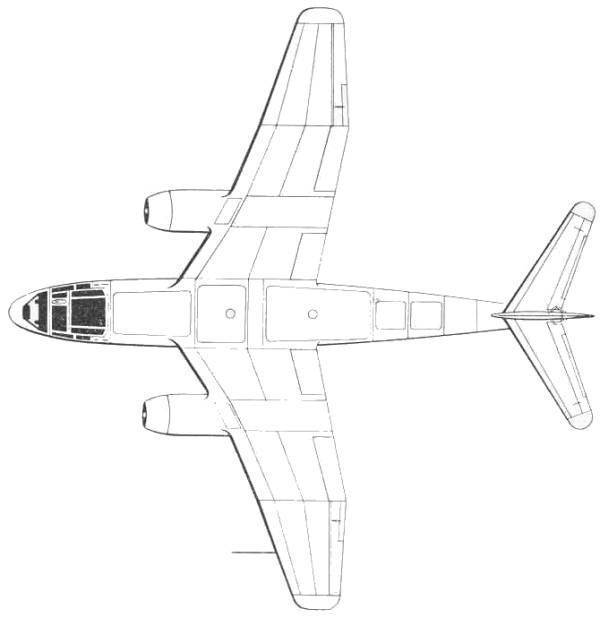
Serial Ar 234B are available in two versions. The Ar 234B-1 variant was a reconnaissance aircraft with two Rb 50 / 30 or Rb 75 / 30 cameras, without small arms. Take-off weight reached 9200 kg, maximum speed up to 780 km / h, range 1950 km, and practical ceiling 11500 m. It was supposed to use this machine as a fighter, while cameras were shot, and under the fuselage a pair of fixed 20-mm guns were mounted in the fuselage MG 151.
It was Ar 234B-2 that became the world's first production bomber with turbojet engines. It was equipped with two fixed MG 151 aircraft guns (250 ammunition for projectiles on the barrel) and directed backwards. Bomb load weighing up to 1500 kg was placed under the fuselage and engine nacelles. For aiming when shooting was used periscope sight PV-1В, mounted on top of the cabin. To combat icing under the protective glass lenses placed heaters. The front aiming lens was used for dive-bombing, and the rear one - for firing at an attacking enemy fighter. Switching the direction of aiming was carried out by appropriate permutation of the optical prism of the sight.
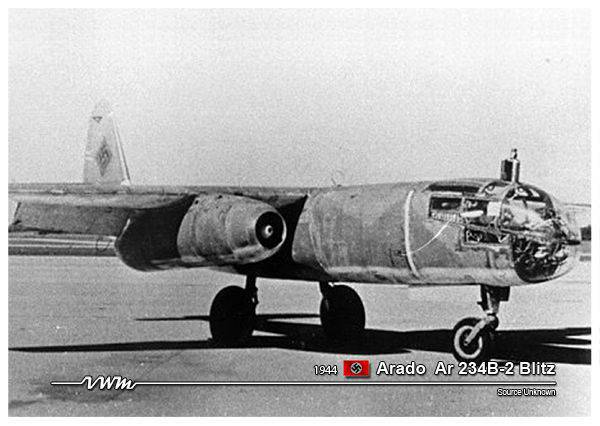
For horizontal bombing, an automated Lotfe-7k synchronized bomber sight was used, linked to the autopilot. In the sight of the onboard computer VZA-1 entered the indicators of the height and speed of the bomber. In addition, the pilot manually set the speed and direction of the wind, as well as the ballistic coefficient of the bomb. When approaching the target, the pilot turned on the autopilot and turned the sight, directing the vertical axis of the grid at the target. The movement of the sight was transmitted to the autopilot, and the bomber automatically went to the combat course. Then the pilot, turning the tracking prism of the sight, threw the sighting beam forward and superimposed the grid crosshair on the target, after which he switched on the toggle switch of the synchronous mechanism. The latter turned the prism of the sight, and, therefore, the sighting beam, back with an angular velocity corresponding to the movement of the aircraft relative to the selected target. Due to this, the crosshair of the grid covered the target during the approach of the aircraft to the moment of dropping the bombs. The dropping of the bomb load (salvo or single) was performed automatically, at the moment when the sighting beam rose with the vertical at a given angle.
During the war years, the 210 series B machines were built at the plant in Alt-Lenniewice. However, due to lack of fuel and confusion that prevailed in Germany in 1945, less than 70% of vehicles fell into combat units.
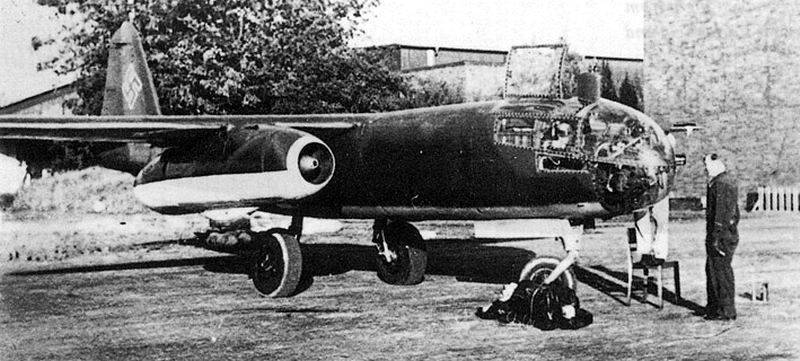
The combat use of Ar 234B began in September 1944 of the year, when the first four Ar 1B-234 was set up in the reconnaissance sunder command Teyts reconnaissance team that had just been formed on the basis of the 1 squadron of a compound of experienced aircraft. The main task of this team was to conduct intelligence of the coast of England. By December, two more reconnaissance zonderkommandoh "Hecht" and "Sperling". By the beginning of 1945, they were disbanded, and the planes were transferred to the first squadrons of the 33, 100, and 123 groups of long-range reconnaissance aircraft.
The first Ar 234B-2 bombers in the fall of 1944 of the year were sent to the staff squadron of the 76 th bomber squadron (Stab./KG 76). In January, the 1945 th bombers were already in three groups of the squadron, it should be noted that none of the groups was fully equipped. In February, near Zegelsdorf, due to the failure of the engine, made an emergency landing of Ar 234B-2 from III / KG 76. The following year, this car was captured by the advancing American troops.
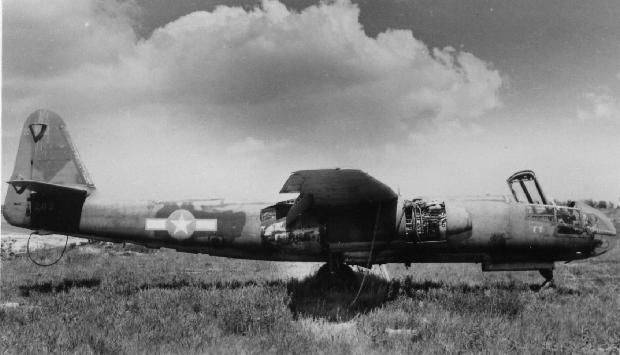
Before the end of the war, research was conducted at the Rechlin Flight Test Center to expand the field of combat use of Ar 234B-2. It was supposed to use the aircraft for towing a cruise missile Fi 103 (V-1), which was equipped for take-off drop landing gear. To increase the range, the towing of a fuel tank with a volume of 2800 l, in which the cable was simultaneously a fuel line, was also worked out.
Further upgrades to the Ag 234 were carried out mainly in terms of increasing the maximum speed. Machines of the C series, as mentioned above, instead of a pair of TRDs Jumo 004B-2 were equipped with four BM W 003A-1, located in twin gondolas under the wing. The dimensions of the aircraft of this and all subsequent series (except F and P) were similar to series B.
For the C series, it was planned to build twelve prototypes of Ar 234V-19 - Ar 234V-30. The first flight of the Ar 234V-19 took place in the autumn of 1944. In total, eight modifications of this series were developed, of which only Ag 234С-1 and Ar 234C-3 were built. The first is a single recon, with four fixed-speed MG 151 guns (a pair in the bow for firing at the course and two in the tail for firing back). The take-off weight of the aircraft is 9900 kg, the maximum horizontal flight speed is 870 km / h, the range is 1470 km, the practical ceiling is 11530m.
Ar 234C-3 (prototype Ag 234V-21) - single bomber and night fighter with a quartet of MG 151 cannons (in the bomber version they were located in the same way as reconnaissance C-1, in the fighter version - two guns in the nose and fairing bottom of the fuselage). The take-off weight of the vehicle is 11555 kg, the maximum combat load is up to 1500 kg, the speed of horizontal flight is 890 km / h, the range is 1230 km, the flight height is up to 11530 m. In total, the 218 experimental aircraft were built from this series (the unfinished Ar 10V-234 and Ar 26V-234 machines destined for the study of the laminar profile wing were destroyed) and the 30 serial only partially equipped engines. In the combat part of these machines are not hit.
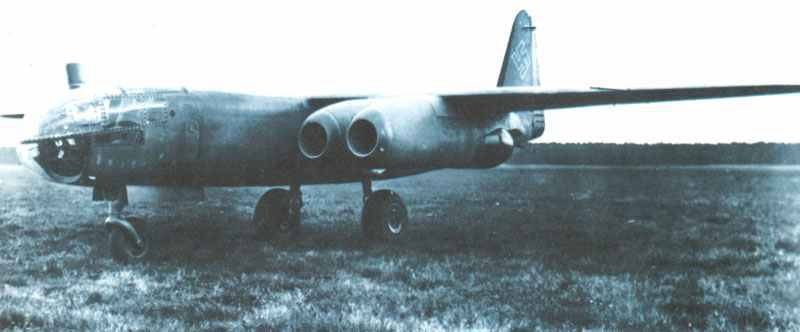
Like the B series aircraft, the Ar 234C was tested on flights with a towed extra fuel tank with a capacity of 4000 l. The methods of towing a Hs 294 cruise missile and a winged bomb weighing 1400 kg, as well as launching the Fi 103 from the “back” of the aircraft, were worked out, which was intended by the mechanism that lifted it at the moment of launch over the carrier. One of the Ar 234C was tested with an antenna mounted on its back in a disk fairing and intended for series R aircraft.
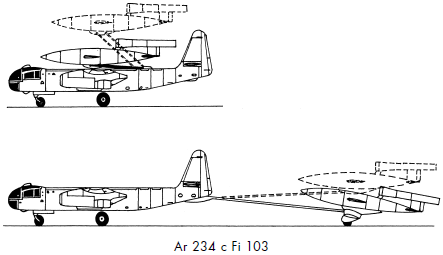
For Ag 234 in the fall of 1944, the company developed a draft radio-controlled planning projectile Ar E.377 with a warhead weighing 2000 kg, with the carrier mounted on a glider. The takeoff was supposed to be carried out using a drop start carriage, and in joint flight the Arado engines were supposed to be powered from a glider tank. The take-off weight of the hitch was about 20000 kg, the range was 2000 km, the maximum speed up to 650 km / h.
At the end of the 1944 of the year specifically for the Ar 234-3 developed a missile interceptor Ar E. 381, suspended under the carrier fuselage. Coupling designed to deal with the massive daily raids of Allied bombers.
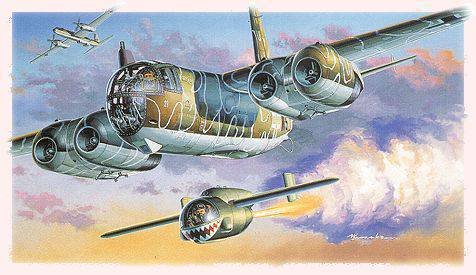
The prototype of the D series was ten experimental machines (from Ar 234V-31 to Ar 234V-40). The single Ar 234D with two engines HeS 011А was developed in versions of reconnaissance (Ar 234D-1) and bomber (Ar 234D-2). By the time the plant was captured by the Allied forces, only two of the prototypes in the assembly had been completed.
The E-series are single-seaters that resembled the D-series cars, and the F-series with increased dimensions was calculated for four HeS 011 A engines or a pair of Jumo 012.
The P series consisted of four variants of a night fighter with cannon armament (for a pair of MK-108 and MG-151) and a three-seater Ar 234P-5 (including the AWACO version) with aircraft length increased to 13,26 m. Among them were: Ar 234P-1 - with four BMW 003A, Ar 234P-3 - with two HeS 011A. Ar 234P-4 - with two Jumo 004D TRDs (MK 108 rapid-fire guns and one MG 151 forward fire and two 108 MCs for firing at an angle up and back).
Ar 234P-5 - with two HeS 011A. Armament - four guns MK 108 (two for firing up) and one MG 151, for firing at the rate. Planned to install the aircraft radar FuG 245 "Bremep". One of the variants of the machine (command fighter) was supposed to have a rotating antenna in the disk fairing on the fuselage.
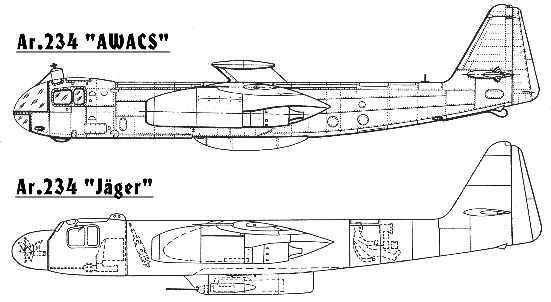
The first acquaintance of the Soviet specialists with the "Arado" occurred in the spring of 1946 of the year, when at the German aerodrome of Darmgarten they discovered its twin-engine version in flying condition. It was not possible to take out the car, and a test team headed by P.M. flew to Germany. Stefanovsky. In Darmgarten, WFP was short, and test pilot A.G. Kubyshkin, after replacing one of the engines, drove the car to the test center in Rechlin. In the course of short-term tests, the low reliability of German TRDs was revealed, which prevented the aircraft from overtaking an aircraft in NII VVS. However, some flight characteristics still determined.
In the process of testing the pilot Kubyshkin had to be the first of the Soviet pilots to get acquainted with the braking parachute. During one of the flights, an engine fire broke out, and the landing gear-release system also failed. There was only one way out - an immediate landing. While Kubyshkin dealt with the "rebellious plane," the runway appeared under the wing, and the landing had to be done with a big blunder. It was here that the braking parachute came in handy, stopping the “Arado” a few dozen meters from the forest.
As in the case of Me 262, the Soviet military "Arado 234" interested. After all, it was the only almost finished jet bomber ended the war. In 1946, according to a government decree, an OKB was set up at plant No. XXUMX, headed by I.V. Chetverikov. A small team of designers was tasked with developing a single bomber capable of flying at speeds up to 458 km / h, having a practical ceiling of up to 750 m and a range of at least 12000 km with a normal bomb load of 1600 kg (maximum -1000 kg) . The new bomber was designed in two versions: with four BMW 1500 turbojet engines and two Jumo 003.
In the same year, the draft design of the machine presented to the customer. However, the leadership of the Air Force made a request to rework the project, remaking the single bomber into a multi-seat one and equipping it with mobile defensive armament. The Ministry of Aviation Industry did not agree with this, and further work on the aircraft stopped. As for the captured cars, one of them was restored to a flying state and was used in LII (1946) for testing brake parachutes.
After the end of the war, two captured Ar 234B and Ar 234C were taken to the USSR, but they were not preserved. The only surviving copy of Ar 234B is at the Smithsonian Institution (USA).
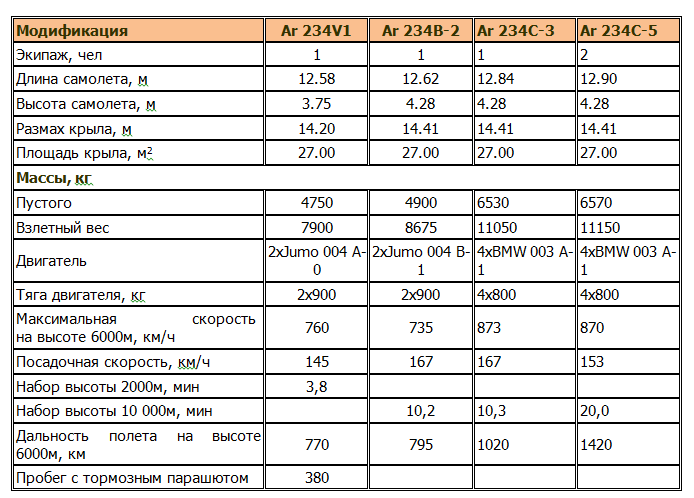
Sources:
Green V. Arado Ar 234 // Aviation and Cosmonautics. 1994. No.2. C.55-61.
Ivanov S. Ar 234 // War in the air. 2005. No.133. C. 11-27.
Kozyrev V., Kozyrev M. Multi-purpose jet. // Wings of the Motherland. 1999. No. 5. C. 7-11.
Stepanov T. Arado 234. // M-Hobby. 1994. No.1. C. 8-9, 40.
Khazanov D. And again about the jet Arado. // M-Hobby. 1994. No.2. C. 26-30.
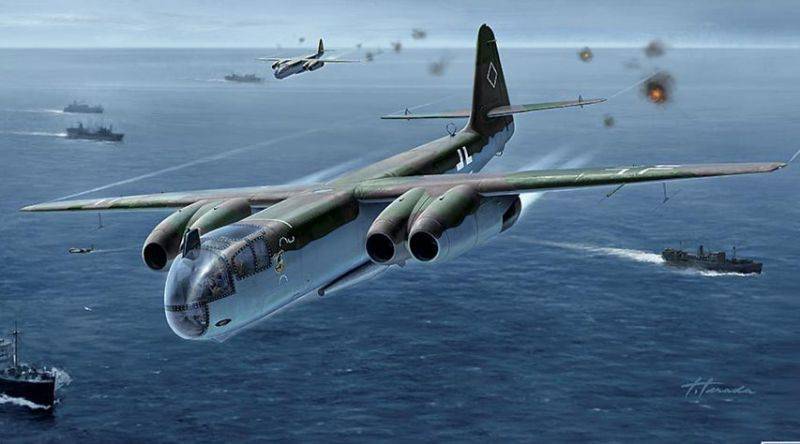
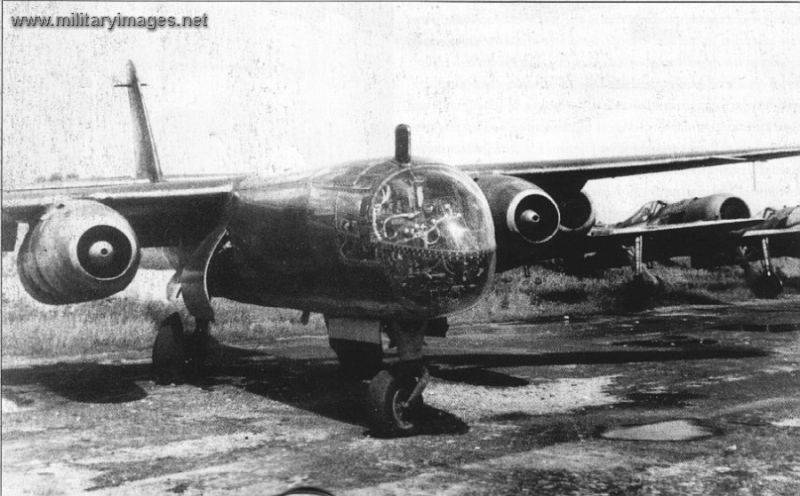
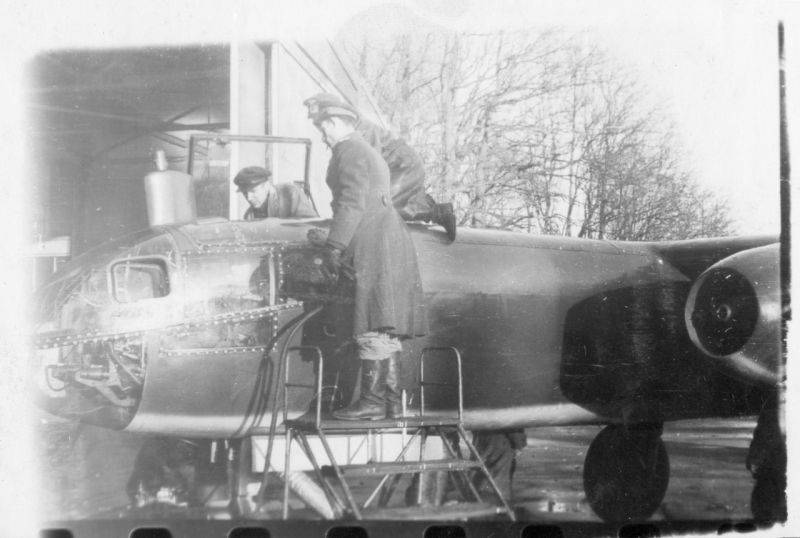
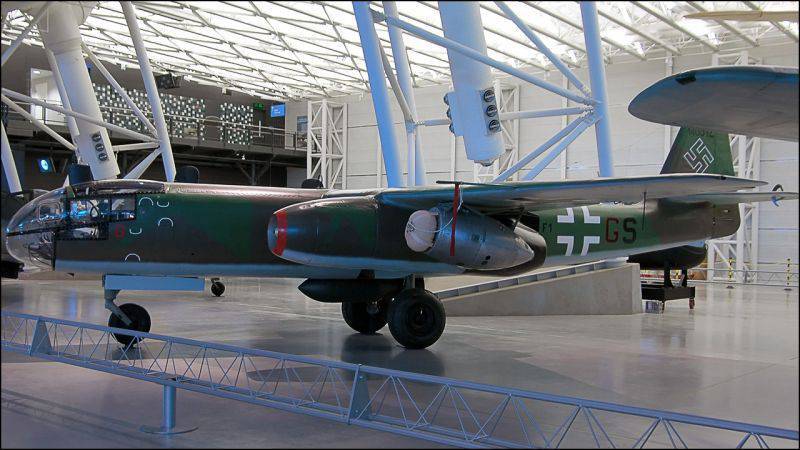
Information